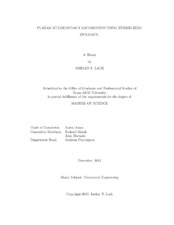| dc.description.abstract | This thesis proposes a method for generating multi-contact, humanlike locomotion via a human-inspired optimization. The chief objective of this work is to offer an initial solution for obtaining multi-domain walking gaits containing domains with differing degrees of actuation. Motivated by the fact that locomotion inherently includes impacts, a hybrid systems approach is used. Through Lagrangian mechanics, a dynamic model of the system is derived that governs the continuous dynamics, while the dynamics during the impacts are modeled assuming perfectly plastic impacts in which the ground imparts an impulsive force on the impacting link.
Using the dynamic model of the planar bipedal robot Amber 2, a seven link biped, a human-inspired optimization is presented which leverages the concept of zero dynamics, allowing for a low dimensional representation of the full order dynamics. Within the optimization, constraints are constructed based on the interaction be- tween the robot and the walking surface that ensure the optimized gait is physically realizable. Other constraints can be used to influence or “shape” the optimized walking gait such as kinematic and/or torque constraints. This optimized walking gait is then realized through the method of Input/Output Linearization. Finally, the utilization of online optimization in the form of a quadratic program increase the capabilities of simple Input/Output Linearization by introducing a notion of optimality as well as the ability to distribute torque as necessary to meet actuator requirements. Ultimately the combination of the flexability of the human-inspired optimization along with the controllers described result in not only multi-domain human-like walking, but even more importantly a tool for rapidly designing new walking gaits. | en |


